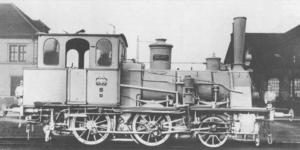Badische I c
| Badische I c | |
|---|---|
|
No. 60
|
|
| Numbering: | 60, 63, 65 |
| Number: | 3 |
| Manufacturer: | Mechanical Engineering Society Karlsruhe |
| Year of construction (s): | 1880 |
| Type : | 1B n2t |
| Gauge : | 1435 mm ( standard gauge ) |
| Length over buffers: | 8600 mm |
| Total wheelbase: | 3700 mm |
| Empty mass: | 24.6 t |
| Service mass: | 29.8 t |
| Friction mass: | 22.67 t |
| Wheel set mass : | 11.4 t |
| Top speed: | 60 km / h |
| Driving wheel diameter: | 1220 mm |
| Impeller diameter front: | 970 mm |
| Control type : | Stephenson |
| Cylinder diameter: | 260 mm |
| Piston stroke: | 450 mm |
| Boiler overpressure: | 9 bar |
| Number of heating pipes: | 112 |
| Heating pipe length: | 2900 mm |
| Grate area: | 0.90 m² |
| Radiant heating surface: | 4.67 m² |
| Tubular heating surface: | 36.73 m² |
| Evaporation heating surface: | 41.40 m² |
| Water supply: | 2.70 m³ |
| Fuel supply: | 1.3 tons of coal |
The locomotives of the class I c of the Grand Ducal Baden State Railways were small tank locomotives for operation on the mountain routes of the Odenwald.
history
Older mainline locomotives were initially used for light passenger train service on main and branch lines. Since the operation of these vehicles was uneconomical, some were converted into tank locomotives. In addition, some new tank locomotives were procured.
The three machines of the class I c were designed in the well-known style of the Karlsruhe machine building company, with brass-clad dome and regulator cladding. The locomotives with the serial numbers 991, 992 and 1000, completed in 1880/1881, were given the track numbers 60, 65 and 63.
The locomotives were used from Lauda on the routes from the Odenwald to Heidelberg and Würzburg.
The locomotives were retired before 1923.
Constructive features
The sheet metal frame had an internal water tank.
The long boiler was made from three shots. The standing kettle had a raised fire box cover. The steam dome sat on the rear part of the boiler and was decorated with brass rings. Outer inlet pipes led into the cylinders. The regulator sat on the front boiler section.
The two-cylinder wet steam engine was external. The horizontal cylinders worked on the front coupling axle. The Stephenson control was external.
Leaf springs were used as suspension. With the front coupling axle it was arranged above and with the rear one below the axle. The springs were connected by means of compensating levers. The barrel axle was supported by a leaf spring above the axle.
The screw brakes acted on the rear coupling axle from both sides. The locomotive also had a Riggenbach counter pressure brake . A Westinghouse air brake was installed later.
The sand spreader sanded the front coupling axle from behind. The coal container was located at the rear of the cab.
literature
- Hermann Lohr, Georg Thielmann: Baden Locomotive Archive (= Railway Vehicle Archive 2, 7) . transpress, Berlin 1988, ISBN 3-344-00210-4 .
